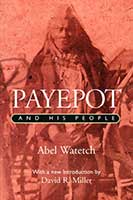by Roland Bohr
History Department University of Winnipeg
|
Abel Watetch, Payepot and His People Regina: Canadian Plains Research Center, University of Regina, 2007, 64 pages, ISBN 0889772010, $14.97 (paperback)
 From the closing decades of the nineteenth century to the middle of the twentieth century, numerous biographical accounts of prominent Aboriginal personalities were published, largely for a non-Aboriginal readership and from a perspective of salvage ethnography and the concept of the “vanishing race.” Payepot and His People differs in some respects from the majority of such accounts because it came from a family member, Payepot’s nephew, Abel Watetch.
From the closing decades of the nineteenth century to the middle of the twentieth century, numerous biographical accounts of prominent Aboriginal personalities were published, largely for a non-Aboriginal readership and from a perspective of salvage ethnography and the concept of the “vanishing race.” Payepot and His People differs in some respects from the majority of such accounts because it came from a family member, Payepot’s nephew, Abel Watetch.
Drawing on family stories, Watetch intended to write about the history of the Piapot First Nation of southern Saskatchewan to “set the record right.” In 1957, the Acting Secretary of the Saskatchewan Arts Board, Blowden Davis, discovered Watetch’s writing project. Their cooperation led to several published versions. It first appeared as a serial in a local newspaper The Western Producer and was published as a book through the Saskatchewan History and Folklore Society in 1957.
Payepot (also spelled “Piapot”) was an important Plains Cree leader who guided his people through a trying time of transition from their life as mobile bison hunters to a new existence on reserves in the last decades of the nineteenth century. As they went through this difficult transitional period, Payepot made a determined effort to keep his people’s central ceremony, the Rain Dance, or Thirst Dance alive as a cultural and spiritual focus in the face of rapid change and strong opposition from government administrators of federal Indian policy and from local clerics.
Thus, Watetch’s account focuses on the importance of the Rain Dance ceremony and its role in maintaining an Aboriginal identity. His account aimed to dispel lingering popular misunderstandings of the Rain Dance, which among other Plains cultures came to be known as the Sun Dance, as a rite of initiation for young Aboriginal men and as a precursor for violence and warfare, when it was actually intended as a spiritual renewal of creation and a reaffirmation of the people’s belief in and devotion to the Creator. One could argue that Payepot and his successors were instrumental in maintaining this ceremony, which has survived since then and is currently practiced on a significant number of southern Canadian reserves.
Payepot spent a part of his childhood among the Dakota as a captive with his grandmother. Watetch points out this fact as the reason for his uncle being called “Nehiyawapot,” or the “Sioux-Cree.” However, the origins of this term are connected to the appellation of Payepot’s people as the “Cree-speaking Assiniboines.” Theirs was a mixed Cree-Assiniboine identity that had emerged out of close contact and intermarriage between bands of the two groups. Payepot and his band maintained contacts to the Assiniboine people on the Fort Belknap Reservation in Montana, which Payepot visited regularly to guide their central ceremonies, such as the Rain Dance.
The book provides important information pertaining to questions of ethnogenesis among Northern Plains peoples and to the transitional period of the late nineteenth and early twentieth century from an Aboriginal perspective. An appendix provides references to corresponding documents from the Northwest Mounted Police and the Department of Indian Affairs, contained in the Sessional Papers of Canada. While this new edition contains two introductions, the original one by Blowden Davis and a new introduction by David Miller, it did not retain most of the original illustrations by Saskatoon artist Bill Perehudoff.
This new and conveniently sized soft-cover edition is of interest to scholars and students, as well as other readers interested in the history of the Canadian Plains, First Nations, southern Saskatchewan and Aboriginal biographical accounts.
Page revised: 14 June 2014